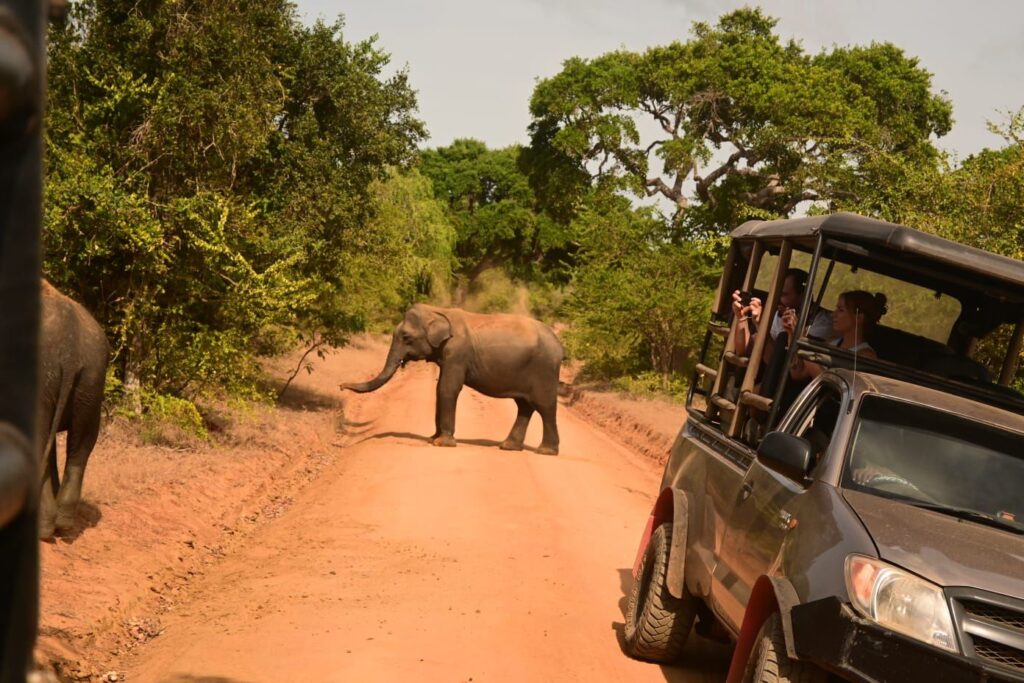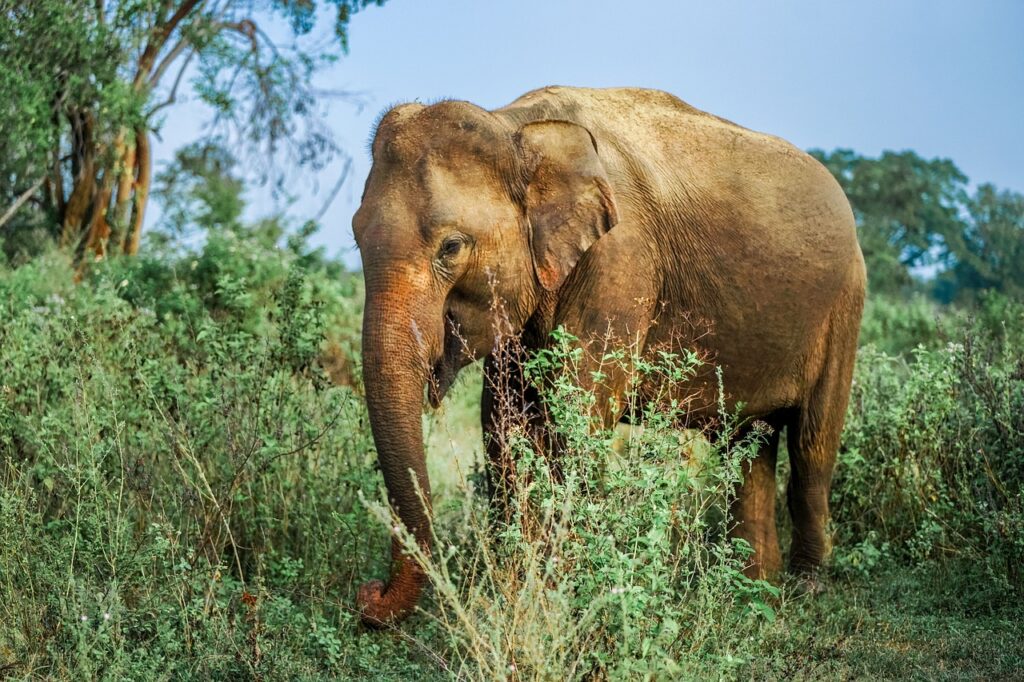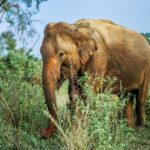Table of Contents
Introduction
Sri Lanka is renowned for its rich biodiversity, making it one of the most appealing destinations for Sri Lanka wildlife enthusiasts. The country’s national parks serve as vital sanctuaries, showcasing a diverse array of flora and fauna. These parks are home to numerous endemic species and offer a glimpse into various unique ecosystems, ranging from lush rainforests to arid plains and coastal regions. As a result, they play a significant role in maintaining ecological balance while offering an unparalleled experience for visitors seeking the best wildlife safaris in Sri Lanka wildlife.
The significance of Sri Lanka wildlife is manifold. It not only supports the biological diversity crucial for environmental stability but also contributes to the economy through eco-tourism. Tourists flock to these national parks, eager to witness the majestic creatures that roam freely in their natural habitats. The interaction between humans and Sri Lanka wildlife fosters greater awareness about conservation and the need to protect these remarkable ecosystems. Icons such as the Sri Lanka wildlife elephant, leopard, and an extensive variety of birds are just a few examples of the unique species that thrive within this vibrant environment.
The country’s strategic location and varied climate dictate the types of ecosystems that flourish here, creating a perfect setting for diverse wildlife. Each national park offers a different ambience and highlights specific species. For instance, Yala National Park is celebrated for its leopards, while Udawalawe is favored by those wishing to encounter large populations of elephants. Understanding the significance of these animals and their roles in the environment enhances the allure of visiting Sri Lanka’s national parks. Therefore, as we explore the top ten animals one must see, it is essential to appreciate how they contribute not only to the ecological tapestry of Sri Lanka wildlife but also to the tourism industry’s growth and sustainability.
Sri Lanka wildlife Elephant
The Sri Lanka wildlife Elephant, scientifically known as Elephas maximus maximus, is a subspecies of the Asian elephant and holds a prominent position in the ecological and cultural landscape of Sri Lanka wildlife. This magnificent creature is the largest and most significant land mammal in the country, reaching a weight of up to 5,000 kilograms and standing 3 meters tall at the shoulder. Characterized by its large ears, which help regulate body temperature, and a long trunk that serves as an essential tool for feeding and social interaction, the Sri Lanka wildlife Elephant is an impressive sight for Sri Lanka wildlife enthusiasts.
Behaviorally, these elephants are social animals, often found in herds led by a matriarch. Their daily activities include foraging for food, which consists mainly of grass, leaves, and fruit, contributing to the ecological balance of their habitat by aiding in seed dispersal. In terms of cultural importance, the Sri Lankan Elephant has deep roots in local traditions, often associated with festivals and spiritual symbolism, underscoring its integral role in the island’s heritage.
For those seeking to witness these majestic animals in their natural habitat, Yala and Minneriya National Parks are among the best wildlife safaris in Sri Lanka. Yala National Park, known for its varied landscapes and diverse wildlife, provides opportunities for elephant sightings, especially around water sources during the dry season. Minneriya National Park is particularly famous for the “Gathering,” an event where hundreds of elephants come together around the Minneriya tank during the months of July to October, making this the ideal time for unforgettable encounters.
Conservation efforts to protect the Sri Lanka wildlife Elephant are paramount, as their population faces threats from habitat loss and human-wildlife conflict. Various organizations and governmental initiatives are striving to ensure the survival of these iconic animals through habitat preservation, community engagement, and anti-poaching measures. This ensures that future generations will continue to admire the incredible Sri Lanka wildlife Elephant in its natural surroundings.
Bengal Tiger
The Bengal Tiger (Panthera tigris tigris), a majestic symbol of strength and beauty, plays a vital role in the ecosystems of Sri Lanka. This top predator profoundly influences the populations of other species, helping to maintain balance within its habitat. The elusive nature of the Bengal Tiger can make it difficult to spot, which adds an element of excitement for wildlife enthusiasts looking to experience the best wildlife safaris in Sri Lanka.
Wilpattu National Park stands out as one of the premier locations for observing these magnificent creatures. The park, which covers over 1,300 square kilometers, is renowned for its unique “villus” or natural lakes, providing vast habitats for tigers and other wildlife. The dense vegetation and secluded areas in Wilpattu offer ideal conditions for tigers to thrive, making it the best choice for those hoping to see them in their natural surroundings.
Bengal Tigers are known for their solitary hunting behavior, primarily feeding on deer and wild boar. Their striking striped coats serve as an effective camouflage against the dappled light of their forest habitats, allowing them to stalk prey undetected. Understanding their hunting patterns is crucial for maximizing the chances of a sighting during a wildlife safari. Additionally, the tigers primarily favor dense forests and grasslands, which provide ample cover and opportunities for ambush.
Despite their critical role in the ecosystem, Bengal Tigers face numerous conservation challenges. Habitat loss due to human encroachment, poaching, and declining prey populations have significantly threatened their survival in Sri Lanka. Active conservation efforts are essential to ensuring the continued presence of these beautiful animals within the country’s national parks. Protecting their habitats and enhancing awareness about their ecological importance will aid in the preservation of Sri Lanka’s rich wildlife heritage.
Sri Lanka wildlife Leopard
The Sri Lankan Leopard (Panthera pardus kotiya) is a subspecies that is endemic to the island, showcasing its unique genetic and evolutionary traits. This magnificent feline exhibits a slender, muscular build, with a distinctive coat featuring a rich yellowish ground color adorned with dark rosettes and spots. Adult leopards can weigh between 80 to 200 pounds, with males generally being larger than females. Their physical prowess makes them formidable predators in the diverse ecosystems of Sri Lanka wildlife, particularly in the renowned Yala National Park.
Yala National Park, located in the southeastern region of Sri Lanka, is celebrated for its high density of leopards. The park’s varied habitats, including scrubland, grassland, and forested areas, provide an ideal setting for these agile hunters. Sri Lankan leopards are primarily nocturnal, utilizing their keen eyesight and acute hearing to pursue a diet that mainly consists of deer, wild boar, and smaller mammals. Their hunting strategies often involve stealth and ambush techniques, taking advantage of their camouflage to blend seamlessly into the environment until they are ready to strike.
The conservation status of the Sri Lankan Leopard is currently classified as Endangered by the International Union for Conservation of Nature (IUCN). Due to habitat loss, poaching, and human-wildlife conflict, efforts to safeguard this elusive species have become increasingly essential. National parks like Yala are at the forefront of these conservation initiatives, employing measures such as anti-poaching patrols and habitat restoration projects. These endeavors aim to preserve the natural habitat of the Sri Lankan Leopard while promoting sustainable tourism practices that highlight the importance of wildlife safaris in Sri Lanka.
4. Blue Whale
The Blue Whale, known scientifically as Balaenoptera musculus, stands as one of the most colossal creatures to roam our planet, captivating the interest of wildlife enthusiasts and researchers alike. These majestic marine mammals, which can reach lengths of up to 100 feet and weigh as much as 200 tons, are primarily found in the deep ocean waters surrounding Sri Lanka wildlife. Their sheer size and grace create a remarkable experience for visitors seeking the best wildlife safaris in Sri Lanka wildlife.
Migration patterns of Blue Whales are influenced by various environmental factors, including water temperature and food availability. The waters off the coast of Sri Lanka wildlife serve as a critical habitat for these whales, particularly around the eastern province of Trincomalee. This region offers some of the most favorable conditions for Blue Whale sightings, as the nutrient-rich waters attract their primary food source—krill. The best times for whale watching in Sri Lanka are typically from November to April, coinciding with the migration of these whales to warmer waters.
National parks in Sri Lanka, such as the marine reserves around Trincomalee, play an instrumental role in the conservation efforts aimed at protecting Blue Whales and their habitats. These protected areas not only serve as safe havens for whales but also foster biodiversity in marine ecosystems. The importance of marine conservation cannot be overstated, as it ensures the survival of these magnificent creatures and promotes the health of ocean environments. As awareness grows, more visitors are encouraged to participate in responsible whale watching that adheres to guidelines designed to minimize any potential disturbances to these gentle giants.
Engaging in activities that promote understanding and protection of Blue Whales enhances the experience of exploring Sri Lanka wildlife. This not only contributes to personal enrichment but also reinforces the significance of conserving marine biodiversity for future generations.
5. Sloth Bear
The Sloth Bear (Melursus ursinus) is an iconic and often overlooked species within Sri Lanka wildlife’s diverse wildlife population. Characterized by its shaggy black fur, long snout, and distinctive white chest patch, the Sloth Bear is primarily nocturnal, making it a fascinating subject for those exploring the national parks of Sri Lanka. Unlike other bear species, Sloth Bears have a unique feeding behavior that is largely insectivorous, with a particular fondness for termites and honey. This specific diet necessitates a specialized method of foraging, as they use their powerful claws to dig into tree trunks and the ground to access these food sources.
Yala National Park and Wilpattu National Park are two of the best wildlife safaris in Sri Lanka wildlife where nature enthusiasts can potentially spot this elusive creature. Given their nocturnal habits, sightings can be rare, but those who venture into these national parks often share stories of successful encounters, particularly during dusk when these bears become more active. These parks provide the dense jungles and rugged terrains that are ideal habitat for the Sloth Bear, allowing them to thrive and play their crucial ecological role in the ecosystem.
Wild Water Buffalo
The Wild Water Buffalo, known scientifically as Bubalus arnee, is a magnificent and endangered species native to the South Asian region. In Sri Lanka, these imposing animals are primarily found in Udawalawe National Park, where their population has become a focal point for wildlife enthusiasts. Given the species’ dwindling numbers, Udawalawe serves as a vital sanctuary that preserves their habitat and offers an opportunity for visitors to observe their natural behavior.
These creatures typically reside in grasslands and wetlands, where they rely on a rich diet of aquatic vegetation and grasses. Wild Water Buffalo display fascinating social structures, often forming herds that can range from a few individuals to up to a hundred. These herds are usually matriarchal, led by the most experienced females, which play a crucial role in the survival of the group. The species is known for its strong bonds; members of the herd exhibit cooperative behaviors, such as grooming and protecting each other, particularly the young and vulnerable.
In addition to their social dynamics, Wild Water Buffalo have adapted well to their environment. They are proficient swimmers, which allows them to navigate through water bodies easily, helping them to avoid predators and find food. Their behavior is influenced by the availability of water, as they are often seen wallowing in mud to regulate their body temperature and protect their skin from parasites.
Conservation efforts aimed at safeguarding the Wild Water Buffalo have been implemented in Udawalawe National Park. Local organizations and the government have initiated programs to monitor their populations and enhance their habitats. Through community engagement and education, these initiatives seek to raise awareness about the importance of preserving the Wild Water Buffalo, ensuring that visitors can continue to enjoy viewing this impressive species in its natural habitat during the best wildlife safaris in Sri Lanka.
Sri Lankan Frogmouth: A Unique Avian Resident
The Sri Lankan Frogmouth (Batrachostomus moniliger) is a remarkable bird that captivates both ornithologists and wildlife enthusiasts alike. Its exceptional ability to camouflage with its surroundings plays a vital role in its survival. Blending seamlessly into tree bark, this elusive species often goes unnoticed, which contributes to its mystique and vulnerability within its native habitat. The Sri Lankan Frogmouth is primarily found in the lush, humid environments of the Sinharaja Forest Reserve and other rich rainforests across Sri Lanka.
Known for its distinctive calls, the male Frogmouth engages in vocalizations during the mating season to attract potential mates, adding an audible facet to their fascinating behavior. These calls can be heard echoing through the national parks, making them a sought-after auditory experience for birdwatchers. Birdwatching enthusiasts visiting the best wildlife safaris in Sri Lanka often prioritize encounters with this unique species, further underscoring the importance of conservation efforts for its populations.
Preservation of the Sri Lanka wildlife Frogmouth and its forest ecosystem is critical, as the species is sensitive to habitat destruction resulting from human activities, such as logging and deforestation. The Sinharaja Forest Reserve serves as a protected area where efforts are underway to maintain its biodiversity. These conservation initiatives not only aim to protect the Sri Lankan Frogmouth but also the multitude of other species that rely on the same habitat. By safeguarding these forests, Sri Lanka can ensure the survival of its unique wildlife, including the Sri Lankan Frogmouth, and enhance the overall health of its ecosystems.
For those seeking a deeper understanding of Sri Lanka wildlife, observing the Sri Lankan Frogmouth in its natural habitat provides a unique glimpse into the broader ecological tapestry of this biodiverse nation. It underscores the critical need for continued conservation efforts to protect not just this avian species, but the entirety of Sri Lanka wildlife invaluable wildlife resource.
8. Green Sea Turtle
The Green Sea Turtle is one of the most iconic marine species found along the shores of Sri Lanka, particularly noted for its significant nesting behaviors. These turtles are primarily known for their remarkable return to the beaches where they were born to lay their eggs, typically occurring during the night. Sri Lanka’s coastlines provide a variety of suitable habitats for these turtles, making the country’s beaches vital for their reproductive success.
Among the notable locations for Green Sea Turtle nesting is the Kosgoda Turtle Hatchery, a dedicated facility that plays a crucial role in marine conservation efforts. This hatchery, established to protect vulnerable turtle nests from poachers and predators, significantly contributes to increasing the population of Green Sea Turtles. Visitors to Kosgoda can observe the nesting process, learn more about the species, and even participate in releasing hatchlings to the sea, promoting awareness and education about the challenges these turtles face.
The importance of national parks in Sri Lanka wildlife extends beyond protecting land mammals; these areas also encompass sections of coastal environments crucial for marine life. Parks like Wilpattu and Yala contribute to broader conservation strategies, aiming to reserve habitats not just for terrestrial species, but also for marine creatures including the Green Sea Turtle. Efforts are ongoing to educate the public about the threats facing these turtles, which include habitat destruction, pollution, and climate change. Collaborative initiatives between governmental and non-governmental organizations have proven effective in raising awareness and mobilizing communities to protect these vulnerable species.
In conclusion, the Green Sea Turtle epitomizes the rich biological diversity found within Sri Lanka’s natural ecosystems. As visitors embark on the best wildlife safaris in Sri Lanka wildlife, understanding the importance of marine habitats and participating in conservation efforts can enhance their experience while contributing meaningfully to the protection of this remarkable species.
Common Langur: A Playful Primate of Sri Lanka
The Common Langur, known scientifically as Semnopithecus entellus, is a widely recognized primate found across various forests in Sri Lanka. These social creatures are characterized by their long limbs, distinctive black faces, and long tails, making them an engaging sight for wildlife enthusiasts. Known for their playful nature and complex social structures, Common Langurs thrive in groups, often seen interacting with one another, grooming, and sharing food. This social behavior adds to their charm, allowing visitors to witness these primates in action during Sri Lanka wildlife safaris.
In terms of feeding habits, Common Langurs are primarily folivorous, consuming a diet rich in leaves, fruits, and flowers. Their ability to adapt to different types of forest environments enables them to forage successfully, thus playing a crucial role in the ecosystem. By consuming leaves and seeds, they contribute to the health of the forest, aiding in plant propagation and maintaining the biodiversity of their habitat. This adaptability allows them to thrive in both dense jungles and the more cultivated areas surrounding historical sites.
One of the best places to observe Common Langurs is at the ancient ruins of Polonnaruwa, where they have become accustomed to the presence of tourists. Here, they can be spotted lounging on stone walls or foraging among the ruins, often providing a delightful distraction for those exploring the site. Their habituation to human presence makes them more visible, offering excellent photographic opportunities for those participating in wildlife safaris in Sri Lanka wildlife. Highlighting their importance, Common Langurs serve not only as an entertaining sight for visitors but also as integral components of their ecosystem, reinforcing the need for conservation efforts in the region.
Conclusion
Sri Lanka is a remarkable destination for Sri Lanka wildlife enthusiasts, offering an extraordinary array of species within its national parks. The rich biodiversity ranges from majestic elephants and elusive leopards to a myriad of endemic bird species and marine life. These animals not only embody the ecological heritage of the country but also attract millions of tourists each year, making Sri Lanka wildlife one of the most sought-after experiences in the region.
Experiencing the best wildlife safaris in Sri Lanka provides visitors a unique opportunity to connect with nature and observe these incredible creatures in their natural habitats. Such encounters can foster a deeper appreciation for wildlife, while also highlighting the importance of conservation efforts. The revenue generated from ecotourism plays a critical role in funding protective measures and habitat restoration programs, ensuring that future generations can also enjoy the splendor of these animals.
It is essential, however, for visitors to engage in responsible tourism practices while exploring these national parks. This includes adhering to guidelines set forth by park authorities, maintaining a safe distance from the Sri Lanka wildlife, and minimizing one’s ecological footprint. By respecting the natural environment and its inhabitants, visitors actively contribute to the sustainability of Sri Lanka’s unique animal populations, safeguarding their existence for years to come.
In conclusion, a visit to Sri Lanka’s national parks is not just a journey through lush landscapes; it is an opportunity to participate in the greater goal of wildlife conservation. By immersing oneself in the beauty of Sri Lanka wildlife, tourists play a vital role in promoting sustainable tourism that benefits both the local communities and the preservation of the astonishing biodiversity that flourishes in this island nation.





















